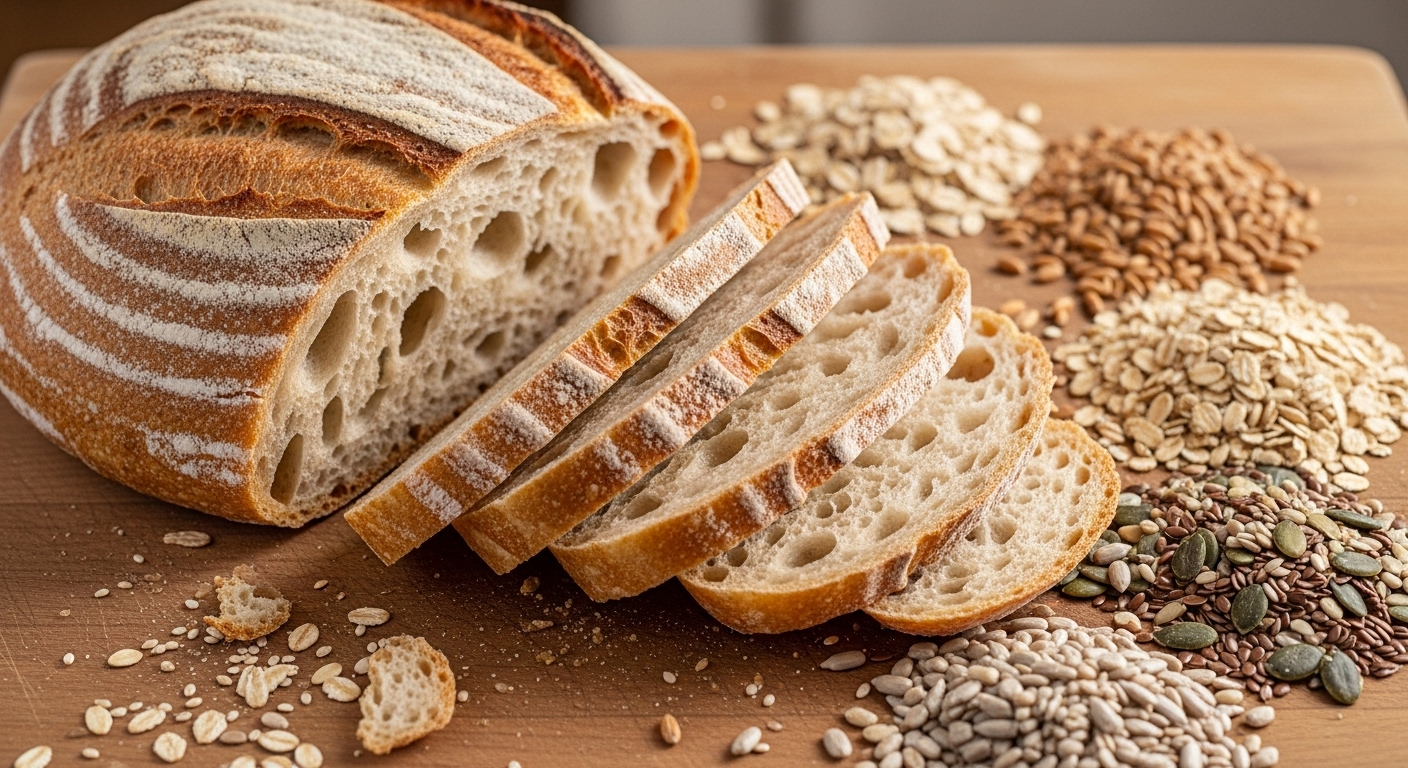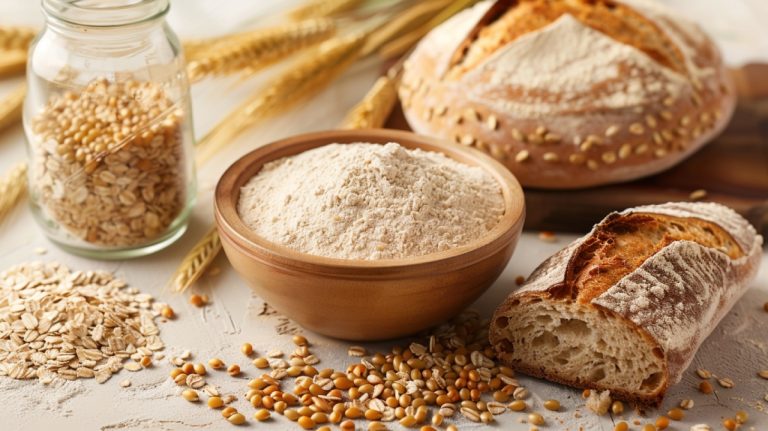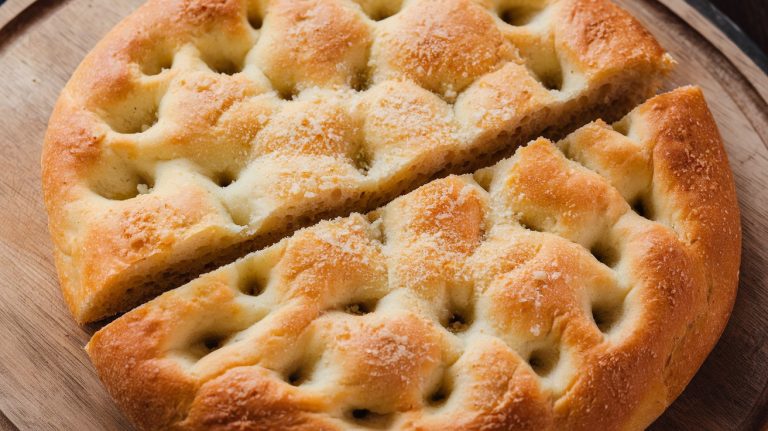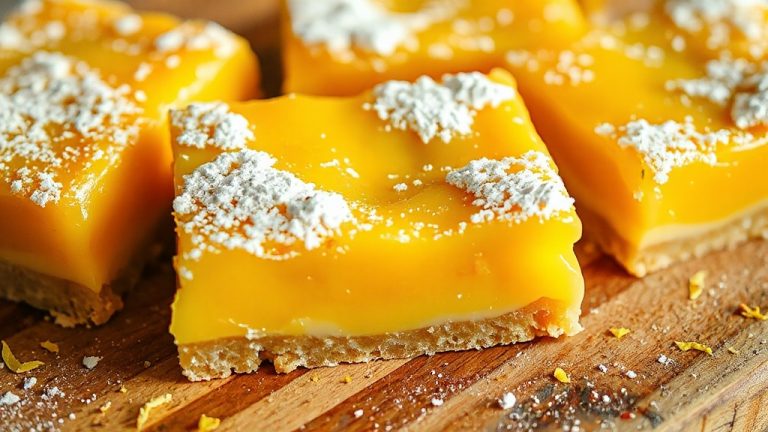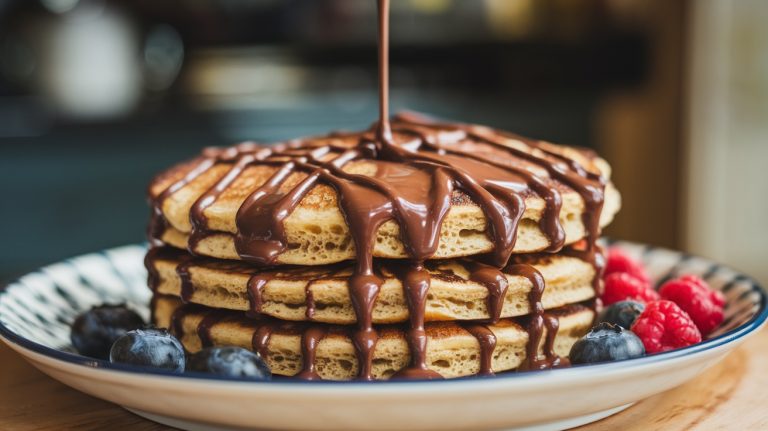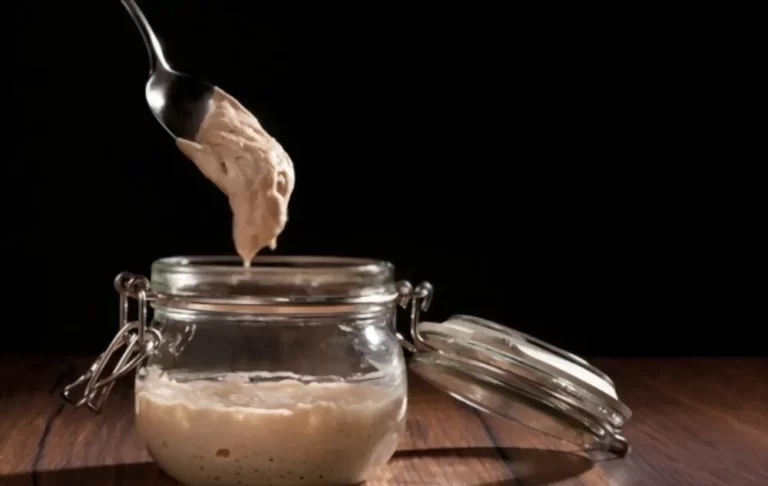Low Calorie Sourdough Bread Recipe for Healthier Snacking
You can make low-calorie sourdough bread by using a blend of whole wheat and bread flours with added fiber-rich seeds soaked to boost nutrient absorption. Start with a well-maintained starter fermented at consistent warm temperatures, then mix and knead the dough properly to develop gluten and texture.
Bake it in a preheated, covered Dutch oven for a crisp crust. Controlling portion size and pairing with protein-rich toppings helps manage calories and blood sugar.
Discover more techniques to optimize nutrition and flavor.
Key Takeaways
- Use a blend of whole wheat and bread flour with added seeds soaked for fiber and nutrient absorption to keep calories low while enhancing nutrition.
- Maintain a consistent sourdough starter feeding schedule at 75–80°F with whole grain flour to optimize fermentation and flavor development.
- Hydrate dough at 65-70% with warm filtered water, avoid sugars, and perform stretch and fold techniques for ideal texture and gluten structure.
- Bake in a preheated Dutch oven at 450–475°F, covered then uncovered, to achieve a crisp crust and perfect crumb.
- Control portions to under 60 g per slice and pair with protein-rich, fiber-dense toppings to balance calories and improve satiety.
Ingredient and Nutrition Comparison for Low Calorie Sourdough Bread
| Ingredient | Quantity | Nutrition Benefit | Preparation Tip |
|---|---|---|---|
| Whole Wheat Flour | 200 g | High fiber, boosts nutrients | Use fresh for better flavor |
| Bread Flour | 200 g | Protein for gluten structure | Sift for lighter texture |
| Filtered Water | 280 ml | Hydration, zero calories | Use warm for active starter |
| Active Sourdough Starter | 100 g | Natural fermentation, gut health | Feed regularly for lively rise |
| Chia/Flax/Sunflower Seeds | 20-40 g | Fiber-rich, heart healthy | Soak overnight for digestibility |
| Fine Sea Salt | 7 g | Regulates yeast, enhances taste | Mix evenly for balanced flavor |
| Oat or Rye Flour | Optional 30-50 g | Extra fiber and minerals | Add for nutritional boost |
Benefits of Low Calorie Sourdough Bread
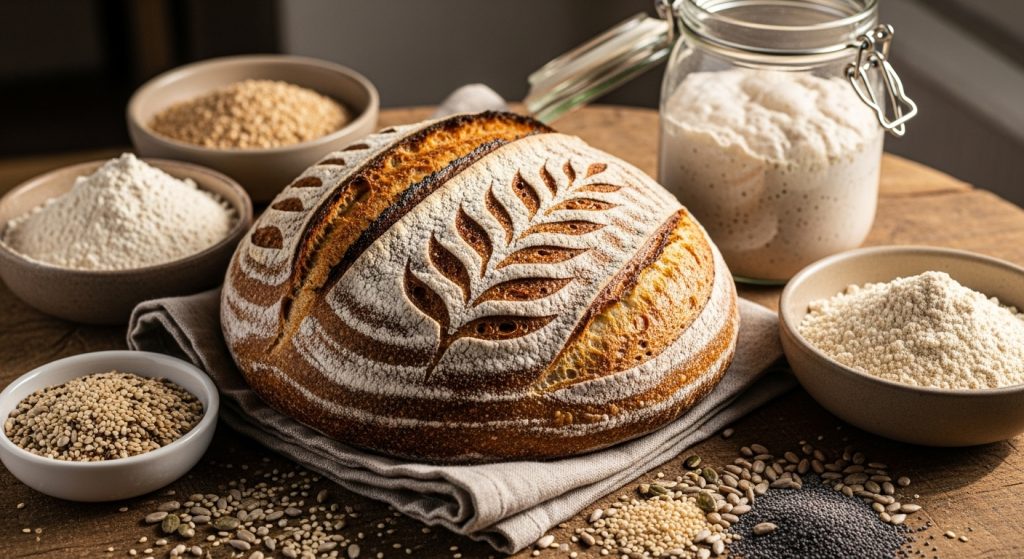
Although you might already enjoy sourdough bread for its taste, choosing a low-calorie version offers significant health benefits that go beyond flavor. Low-calorie sourdough enhances gut health by increasing fiber and polyphenol bioavailability through fermentation, which fuels beneficial gut microbes and promotes a balanced microbiome.
Using proper kneading tools like a dough hook can improve dough consistency, aiding fermentation and texture. It also reduces FODMAP content, easing digestion and minimizing discomfort for IBS sufferers. This bread manages blood sugar effectively; its slow fermentation lowers glycemic index, preventing spikes and supporting longer satiety.
Additionally, the high fiber and antioxidant peptides found in low-calorie sourdough contribute to cardiovascular health by reducing oxidative stress and metabolic strain. It is also a convenient option for busy individuals, as it stays fresh longer and is easy to carry for on-the-go consumption easy storage.
Finally, fermentation partially breaks down gluten and starches, improving digestibility and making it suitable for those with mild gluten sensitivities or digestive issues.
Essential Ingredients for a Healthy Loaf
When crafting a low-calorie sourdough loaf, selecting the right ingredients is crucial to balance nutrition, flavor, and texture. Use a blend of whole wheat and bread flour to enhance fiber and gluten development while keeping calories moderate.
Incorporate whole grains, bran, or alternative flours like rye or oat to increase fiber without adding excess calories. Choosing flours with a high protein content helps improve dough structure and crumb quality.
Maintain hydration around 65-70% with warm filtered water, avoiding added sugars to optimize fermentation and crumb structure. Boost protein and nutrients by adding seeds such as chia, flax, or sunflower seeds, which contribute healthy fats and fiber with minimal calorie increase.
Use fine sea salt for flavor and yeast regulation without adding calories. Precise ingredient measurement ensures consistent calorie control and a wholesome, satisfying loaf. For added nutrition and texture, consider soaking your seeds and oats overnight in water, a technique known as a seed soaker, which improves digestibility and hydration.
Preparing the Sourdough Starter for Optimal Fermentation
Selecting the right ingredients sets the foundation, but nurturing your sourdough starter properly guarantees a lively fermentation that shapes flavor and texture. Use whole wheat or rye flour to jumpstart microbial activity, mixing equal parts flour and warm water (70–80°F) into a thick paste.
This initial use of whole wheat flour is important because it contains more nutrients and wild yeast, which help to kickstart fermentation. Many bakers find that maintaining the starter’s microbial balance is key to consistent results.
Maintain a consistent feeding schedule—daily or twice daily—to stabilize yeast and bacteria, discarding part of the starter before feeding to control volume and refresh nutrients.
Keep the starter at an *ideal* temperature around 75–80°F using warm spots like a proofing box to maximize microbial growth. Avoid temperature extremes to prevent microbial death or sluggish fermentation.
Observe starter phases: initial surge, lull, then vigorous bubbling by day 7–10.
Consistent hydration and feeding ratios ensure predictable fermentation, supporting a balanced microbial community critical for a healthy, active starter.
Step-by-Step Dough Mixing and Kneading Process
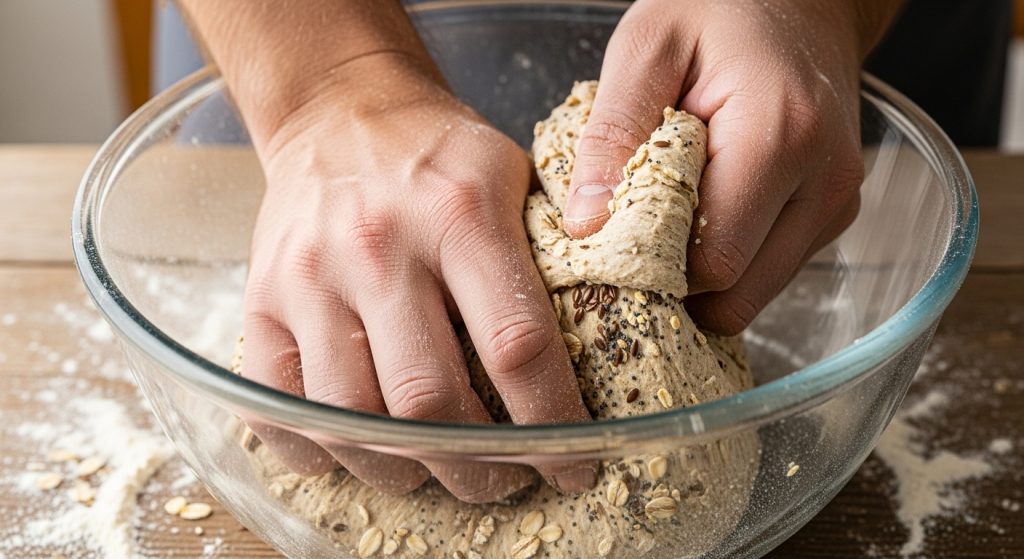
To achieve the ideal dough consistency, start by thoroughly combining your dry ingredients—flour and salt—in a large bowl, ensuring even distribution.
Mix water and sourdough starter separately, then pour into the dry mix, stirring until a wet, shaggy dough forms.
Let it rest for 20 minutes to hydrate the flour.
Next, perform five stretch and fold cycles to develop gluten and strengthen the dough gently, as this method activates gluten in wheat flour for better dough structure and a light, airy crumb.
After initial mixing or rest, knead the dough for 5–6 minutes, incorporating salt fully for elasticity and smoothness.
Techniques for Enhancing Fiber Without Adding Calories
You can boost fiber in your sourdough bread by soaking seeds like flax and chia, which improves hydration and helps them blend seamlessly into the dough without adding calories. Using a blend of whole grain flours such as rye and spelt not only increases insoluble fiber but also enhances the bread’s texture and fermentation qualities.
These techniques work together to maximize fiber content while maintaining a light, low-calorie loaf. Proper storage, such as vacuum sealing, can help maintain the bread’s freshness and texture over time. Incorporating a variety of mixed seeds such as sesame, pumpkin, sunflower, and flax can further enrich the bread’s nutritional profile without significantly increasing calories.
Seed Soaking Benefits
Although seeds are naturally high in fiber, soaking them before adding to your sourdough bread significantly enhances fiber availability without increasing calories. Soaking reduces phytic acid and enzyme inhibitors, which normally impair nutrient absorption and digestion.
Additionally, soaking seeds in water at an appropriate hydration ratio, usually about 1:1.5 water to seeds, ensures optimal softening and integration into the dough. This technique also helps preserve the bread’s nutritional benefits during baking and freezing.
When you soak seeds in an acidic medium like lemon juice or yogurt for 7–12 hours, you break down tough outer layers, increasing soluble fiber bioavailability. This process improves digestibility and allows better integration of fiber into the bread matrix, supporting satiety and gut health without adding calories.
Additionally, soaked seeds retain moisture, which prevents dry, stiff bread and promotes a softer crumb. By incorporating properly soaked seeds, you ensure consistent texture, enhanced nutrient uptake, and improved fiber benefits—all without increasing your bread’s calorie content.
Flour Blends Impact
When selecting flour blends for your sourdough, incorporating whole grain and fiber-rich flours considerably boosts fiber content without adding calories. Replace part of white bread flour with whole wheat, rye, or oat flour to increase fiber three to four times.
Using oat bran or wheat bran further elevates fiber density with minimal calorie impact. Incorporate legume flours like garbanzo to add fiber and protein, enhancing nutrition while maintaining low calories. Additionally, using whole grain flours such as rye, spelt, or whole wheat naturally increases protein content along with fiber.
These flours also contribute to a denser texture that can enhance the bread’s mouthfeel. Balance these blends carefully to preserve gluten structure; a 50:50 whole wheat to bread flour ratio works well, with 10–20% rye for flavor and fiber diversity.
Employing tangzhong improves moisture when adding fiber-rich flours. This approach optimizes fiber content, loaf texture, and satiety without increasing digestible calories, making your low-calorie sourdough both nutritious and palatable.
Baking Tips for a Perfect Low-Calorie Crust and Crumb
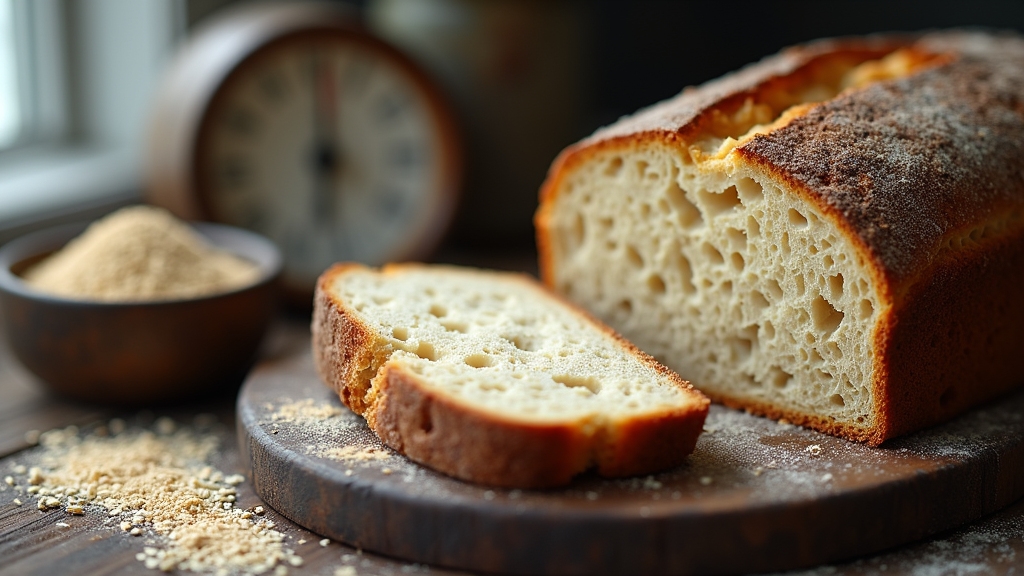
Achieving a perfect low-calorie crust and crumb hinges on mastering dough hydration, fermentation, and baking techniques that enhance texture without adding extra calories. Focus on these key practices to optimize your sourdough:
- Hydration & Fermentation: Use a high hydration dough (~75% water to flour) and incorporate long fermentation with cold retardation. This promotes an open crumb and chewy texture by strengthening gluten and starch gelation without extra fat. Additionally, the natural fermentation process lowers the glycemic index, helping to prevent blood sugar spikes.
- Shaping & Scoring: Create surface tension during shaping to ensure even oven spring. Score just before baking to control expansion and avoid random crust cracks.
- Baking Environment: Preheat your oven and Dutch oven to 450–475°F. Bake covered initially to trap steam, then uncover to develop a thin, crisp crust while preventing moisture buildup.
Applying these evidence-based methods guarantees a light, flavorful low-calorie sourdough with ideal crust and crumb.
Portion Control and Serving Suggestions
To manage calorie intake effectively, controlling sourdough bread portions is essential. Aim for slices under 60 g (half to one medium slice), which provide 100–130 calories and optimize satiety.
Use a kitchen scale or bread slicer to maintain consistent portions. Pair your bread with protein-rich foods like lean meats or eggs, and add fiber-rich veggies or spreads such as avocado for nutrient density. The fermentation process in sourdough enhances nutrient availability, making even smaller portions more beneficial.
Additionally, combining sourdough with protein-rich foods can further improve blood sugar control and meal satisfaction.
Open-faced sandwiches and serving with soups or salads help balance meals while limiting bread calories.
| Serving Tip | Benefit |
|---|---|
| Thin slices (under 60 g) | Reduces calories per serving |
| Protein toppings | Enhances satiety and muscle |
| Fiber-rich spreads | Promotes fullness and digestion |
| Pair with soups/salads | Balances nutrients and calories |
Frequently Asked Questions
How Long Can Low-Calorie Sourdough Bread Be Stored Safely?
You can safely store low-calorie sourdough bread at room temperature for about 1 to 2 days, keeping it in a paper bag or bread box to prevent moisture buildup.
Because it’s denser and contains fiber and seeds, watch closely for mold.
For longer storage, freeze it sliced in an airtight container to preserve freshness and inhibit spoilage.
Always inspect for mold or off smells before eating to confirm safety.
Can I Freeze Low-Calorie Sourdough Bread Without Affecting Texture?
Yes, you can freeze low-calorie sourdough bread without compromising texture if you cool it completely first.
Wrap it tightly in foil or plastic wrap, then place it in an airtight freezer bag, removing excess air to prevent freezer burn.
Freeze whole or sliced loaves based on your needs, and thaw before toasting to restore crust crispness.
Proper freezing halts spoilage and maintains starch structure, preserving texture for up to two months.
What Is the Best Way to Reheat Sourdough Bread?
The best way to reheat sourdough bread is in a preheated oven at 350℉ (175℃).
Defrost fully if frozen, then mist or brush it with water to keep moisture. Wrap it in foil to prevent drying and heat for 10-15 minutes, checking periodically.
This method restores crisp crust and soft crumb effectively.
For quick reheating, toaster ovens and air fryers work well but may reduce moisture retention compared to the oven.
Are There Any Common Allergens in Low-Calorie Sourdough Recipes?
Yes, you’ll commonly find gluten and wheat allergens in low-calorie sourdough recipes since most use wheat flour.
Fermentation reduces gluten but doesn’t eliminate it, so it’s unsafe for those with celiac disease or severe allergies.
Some recipes may include seeds, nuts, or barley, which add other allergens.
If you’re sensitive, always check ingredient lists carefully, as additives or fermentation byproducts like histamine can also trigger reactions.
Can Low-Calorie Sourdough Bread Be Made Gluten-Free?
Yes, you can make low-calorie sourdough bread gluten-free, and it happens to align perfectly with many dietary needs. By swapping traditional wheat flour for gluten-free options like oat fiber, buckwheat, or quinoa, you maintain sourdough’s tangy flavor while lowering calories.
Adding binders like psyllium husk helps with texture. This method simplifies fermentation and keeps the bread nutritious, making it suitable for gluten-sensitive or low-calorie diets without sacrificing taste or health benefits.
Your Path to Better Bread Starts with Low Calorie Sourdough
Did you know that sourdough fermentation can increase the bioavailability of nutrients by up to 30%?
By following this low-calorie sourdough bread recipe, you not only enjoy a delicious loaf but also boost your gut health and nutrient absorption.
With mindful ingredient choices and proper techniques, you can savor a high-fiber, low-calorie bread that supports your wellness goals.
Keep portion control in mind, and you’ll make every bite count toward a healthier lifestyle.

